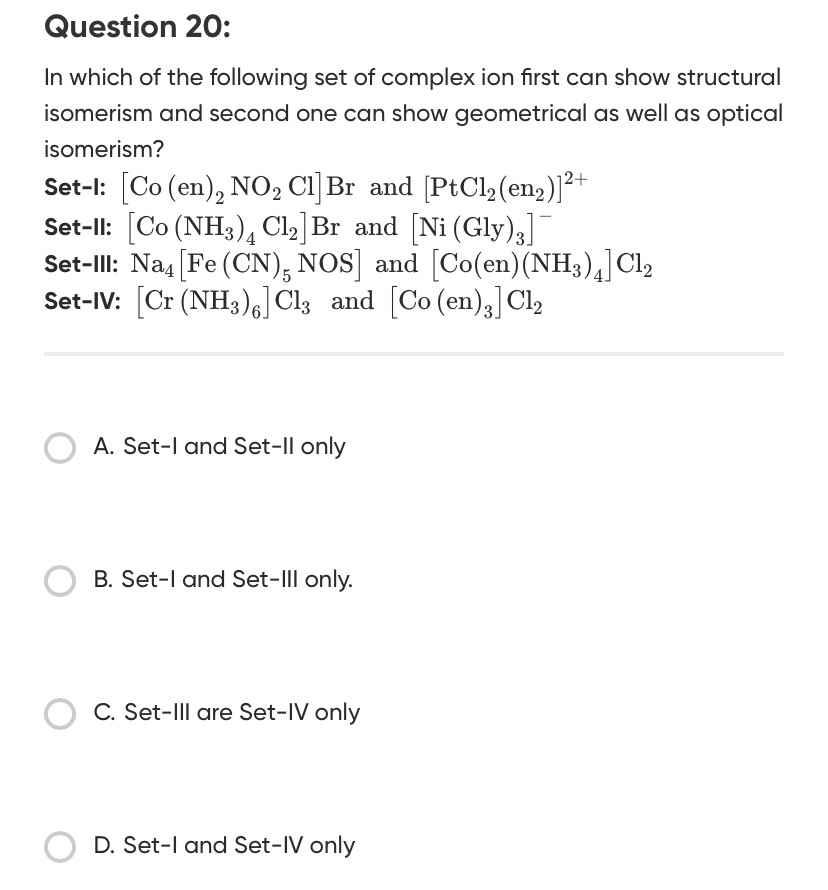Question
Question: In which of the following set of complex ion first can show structural isomerism and second one can ...
In which of the following set of complex ion first can show structural isomerism and second one can show geometrical as well as optical isomerism?

Set-I: [Co(en)2NO2Cl]Br and [PtCl2(en2)]2+
Set-II: [Co(NH3)4Cl2]Br and [Ni(Gly)3]−
Set-III: Na4[Fe(CN)5NOS] and [Co(en)(NH3)4]Cl2
Set-IV: [Cr(NH3)6]Cl3 and [Co(en)3]Cl2
Set-I and Set-II only
Solution
The question requires identifying a set where the first complex exhibits structural isomerism and the second exhibits both geometrical and optical isomerism.
Analysis of Set-I:
-
First complex: [Co(en)2NO2Cl]Br
- Coordination sphere: [Co(en)2NO2Cl]+. This is an octahedral complex of the type [M(AA)2XY].
- Structural Isomerism: The NO2 ligand can coordinate through Nitrogen (nitro, −NO2) or Oxygen (nitrito, −ONO). This is linkage isomerism, a type of structural isomerism.
- Therefore, the first complex shows structural isomerism.
-
Second complex: [PtCl2(en2)]2+ (interpreted as [Pt(en)2Cl2]2+)
-
This is a square planar Platinum(II) complex of the type M(AA)2B2.
-
Geometrical Isomerism: The two en ligands are bidentate and must be in a cis configuration. The two Cl ligands can be arranged in cis or trans positions. Thus, it exhibits geometrical isomerism (cis and trans isomers).
-
Optical Isomerism: The cis isomer of M(AA)2B2 square planar complexes is chiral and exhibits optical isomerism. The trans isomer is achiral.
-
Therefore, the second complex shows geometrical and optical isomerism.
-
Conclusion for Set-I: Both conditions are met.
-
Analysis of Set-II:
-
First complex: [Co(NH3)4Cl2]Br
- Coordination sphere: [Co(NH3)4Cl2]+. This is an octahedral complex of the type MA4B2.
- Structural Isomerism: The two Cl ligands can be adjacent (cis) or opposite (trans). This is geometrical isomerism, a type of structural isomerism.
- Therefore, the first complex shows structural isomerism.
-
Second complex: [Ni(Gly)3]−
-
Glycine (Gly) is an unsymmetric bidentate ligand (H2NCH2COO−). This is an octahedral complex of the type M(AB)3.
-
Geometrical Isomerism: Octahedral complexes of the type M(AB)3 exhibit geometrical isomerism in the form of facial (fac) and meridional (mer) isomers.
-
Optical Isomerism: Both the fac and mer isomers of M(AB)3 type complexes with unsymmetric bidentate ligands can be chiral and exhibit optical isomerism.
-
Therefore, the second complex shows geometrical and optical isomerism.
-
Conclusion for Set-II: Both conditions are met.
-
Analysis of Set-III:
- First complex: Na4[Fe(CN)5NOS]
- The ligand NOS can exhibit linkage isomerism, leading to structural isomerism.
- Second complex: [Co(en)(NH3)4]Cl2
- Coordination sphere: [Co(en)(NH3)4]2+. This is an octahedral complex of the type [M(AA)A4].
- Geometrical Isomerism: In [M(AA)A4] complexes, the bidentate ligand (en) occupies cis positions. The remaining four positions are occupied by identical monodentate ligands (NH3). All four positions for NH3 are equivalent relative to the en ligand. This complex does not exhibit geometrical isomerism.
- Since the second complex does not show geometrical isomerism, Set-III is invalid.
Analysis of Set-IV:
- First complex: [Cr(NH3)6]Cl3
- This is an octahedral complex of the type MA6.
- Structural Isomerism: Complexes of the type MA6 do not exhibit any form of structural isomerism.
- Since the first complex does not show structural isomerism, Set-IV is invalid.
Final Conclusion: Both Set-I and Set-II satisfy the conditions. Set-I has a first complex showing linkage isomerism (structural) and a second complex showing geometrical and optical isomerism. Set-II has a first complex showing geometrical isomerism (structural) and a second complex showing geometrical and optical isomerism.
